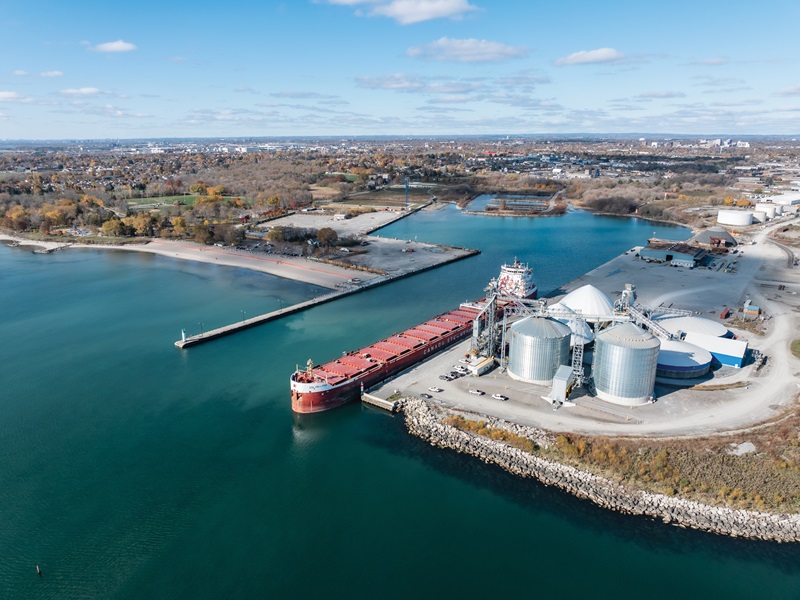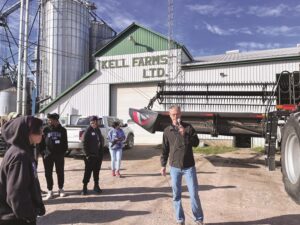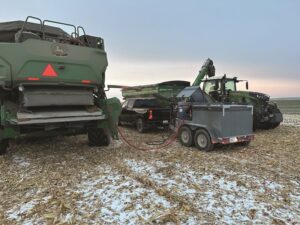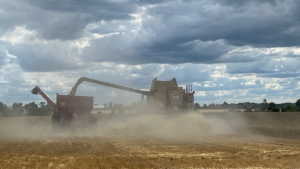Ontario ports’ expansion
Optimism is widespread

Optimism is a key characteristic of grain market transportation in Ontario right now, driven by extensive port and terminal expansion taking place across the Great Lakes and St. Lawrence Seaway system.
Significant investments by private industry, as well as the federal and provincial governments, have put the grain sector well ahead of others in contemplating how to navigate this era of global uncertainty and troubled geopolitics. Such instability has shone a light on the infrastructure underpinning food security, increasing the appreciation and understanding of the Seaway and port expansion plans.
Dana Dickerson, Grain Farmers of Ontario’s director of market development and sustainability, notes other inland grain- producing regions, particularly Western Canada and the U.S. Midwest, count mostly on rail to move grain.
“The seaway and its ports are a rare and unparalleled transportation asset in the grain sector and in close promixity to our growing region give Ontario farmers a leg up,” she says. “They minimize risk…they’re an incredible advantage.”
Adds Grain Farmers of Ontario chief executive officer, Crosby Devitt: “Ontario has a rich history of port and terminal development. Some of the infrastructure was built more than a century ago, and it’s critical that it be modernized to ensure it’s available for the next 100 years. The growth in grain production in Ontario has created many opportunities for grain handlers, exporters, and processors, and we all have a stake in keeping the momentum.”
Grain Farmers of Ontario is vigorously supporting port expansion by participating in inbound and outbound trade missions, supporting business case development, and helping port and grain terminal project proponents advocate to the government to unlock development barriers and attract investment.
Dickerson says domestic and foreign grain customers have taken note of the port and terminal activity.
“They’re really impressed with what they’re seeing,” she says. “The investment, the technology, the attention to detail by the industry is getting buyers’ attention. It’s really striking when you look at the big picture of what’s happening in Ontario, and we want to help unlock development opportunities by emphasizing our farmers’ reliability, consistency, and sustainability.”
The expansion effort features many significant developments.
TRADE-ENABLING INFRASTRUCTURE IN HAMILTON AND OSHAWA
Agri-food commodities shipped through the Hamilton-Oshawa Port Authority (HOPA) reached a combined total of 3.42 million tonnes last year, maintaining agri-food’s position as a cornerstone of HOPA’s cargo mix. Agri-food now represents 31 per cent of total cargo volume, driven by a decade of what the organization calls “investment in trade-enabling infrastructure.”
Parrish and Heimbecker (P&H) is a major player here. In Hamilton, P&H realized a milestone in 2017 with the opening of Ontario’s first new flour mill in 75 years. By 2020, the addition of a second mill doubled its processing capacity. Now, with a third mill under construction, P&H continues to meet the rising demand for quality ingredients in the baking and food manufacturing industries. Construction is expected to be completed late this year. This expansion also includes two new storage silos for handling essential feed ingredients such as soymeal, distillers dried grains, and wheat to service the flour mills.
Meanwhile, at the Port of Oshawa, the newly expanded grain terminal there now offers 20,000 tonnes of storage capacity and features a sell loading rate of up to 12,000 tonnes per day. A new dual truck unloading structure, capable of receiving 700 tonnes of grain per hour, will streamline deliveries and minimize delays. The facility also has weather protection and a modern dust control system.
In 2024, the Port of Oshawa received more than 54,000 tonnes of grain from regional farmers for export to international markets.
GODERICH POISED FOR HUGE EXPANSION ANNOUNCEMENT
The increasingly busy Port of Goderich, which currently welcomes about 220 ships annually, is poised for a huge expansion announcement that could come as soon as October 2025.
Goderich Port Management Corporation president, Frank Hurkmans, says the pieces are firmly in place for an 11-acre, $65-million expansion that will make the port a container-receipt terminal on top of its other functions, handling as many as 10,000 containers annually.
Hurkmans describes it as a “shovel-ready project,” and pending funding approvals, this expansion would wrap up in the fall of 2028.
Hurkmans expects grain to continue to comprise about 20 per cent of the material handled by the port. However, container capacity means significantly more agricultural products, such as fertilizer and seed, will pass through the port, improving access for southern Ontario producers and agribusiness.
Hurkmans and his team are also working to raise $3 million to rebuild the port’s agri-dome, which was destroyed in the 2011 tornado that levelled much of the town. Plans call for the agri-dome to provide 30,000 tonnes of sheltered holding capacity.
And finally, this year the port’s winter shore-power-ready berthing capacity will grow to moor five ships, up from two last year. That’s a boon to the local economy and a nod to the port’s capabilities.
“We’re running at 110 per cent,” says Hurkmans, “and we’re running out of space. We’re anxious to grow our footprint.”
JOHNSTOWN: BUILDING A SUPPLY CHAIN SOLUTION
At the Port of Johnstown, 100 kilometres south of Ottawa, V6 Agronomy is building what it calls a low-carbon terminal. From this facility, V6 will receive, store, and distribute a range of critical crop inputs, including enhanced efficiency fertilizers (EEFs) and commercial phosphates—a nutrient essential to modern agriculture and one that Canada currently produces none of domestically.
The $2.6-million initial structure, for which construction began in July, will support vessel discharge capacity up to 18,000 tonnes. It’s the first of four planned buildings that will collectively store up to 150,000 tonnes of crop input materials on-site.
“We’re doing more than building a structure—we’re building a supply chain solution,” says Ryan Brophy, CEO of V6 Agronomy. “This is a new chapter for Canadian agriculture, where resilience, efficiency, and international trade intersect in a circular, farmer-first corridor. We’re eliminating inefficiencies, reducing emissions, and leveraging assets that already exist. Marine, rail, and storage in one place.”
Brophy says the terminal marks phase one of a broader national infrastructure strategy. As he explains, Canadian farmers have long depended on U.S. imports routed through New Orleans and the Mississippi corridor, creating price and timing vulnerabilities. Now, V6 Agronomy’s facility will help re-shore that dependency while connecting directly to the Canadian prairies by rail and to local farms by truck, using a turnkey vessel-to-rail and rail-to-vessel configuration.
In collaboration with CN Rail, V6 is implementing a circular logistics model to reduce empty rail and vessel returns. Outbound phosphate shipments by rail will be paired with return loads of Canadian lentils, pulses, potash, grains, and sulphur, all high-demand commodities in Europe, the Middle East, North Africa, and Asia.
The initial structure is expected to be complete this year. V6 Agronomy is seeking strategic capital to accelerate infrastructure development and build national distribution capacity.
PORT WINDSOR EXPANSION SCHEDULED TO WRAP UP SHORTLY
A $76-million expansion at Port Windsor by ADM is scheduled to wrap up shortly. The expansion is a “transformative project” that will significantly increase ADM’s export capacity to global markets and support agricultural production from southwestern Ontario farmers, says Dane Lisser, ADM’s media relations manager. Several of the phases of the construction project are complete, with one portion expected to be operational this fall.
The company received $26.3 million from Ottawa for this project. “We tremendously value Transport Canada’s partnership and financial support of the expansion project,” Lisser says
NEW BULK TERMINAL CONSTRUCTION IN PICTON
A new bulk agricultural marine terminal at Picton Terminals in Prince Edward County will support eastern Ontario farmers by offering a closer, more efficient delivery option for their corn, wheat, and soybeans.
The new terminal, a joint effort by the Doornekamp Group (Picton Terminals’ operator) and P&H, is designed to significantly reduce travel time for local farmers, alleviate truck traffic on Highway 401 and enhance the overall efficiency of the agricultural supply chain.
With high throughput and rapid turnover capabilities, this facility is designed to meet the needs of the region’s farmers while expanding P&H’s export capacity, which currently serves customers in 24 countries.
The construction of storage silos and receiving buildings is underway. The project is slated for completion next year.
PORT COLBORNE RESIDENTS WANT GRAIN HUB
In Port Colborne, the city is inviting what it calls “new, creative, and/or innovative perspectives” on how its aging 125-year-old grain terminal and surrounding property on the shores of Lake Erie can best be operated or developed.
Ownership of the grain terminal was transferred from the Canada Ports Corporation to the City of Port Colborne in 1999. For the past 10 years, Parrish and Heimbecker, the Great Lakes’ largest grain handler, was the facility’s proprietor. But the company ended that arrangement last December, and it’s been empty since.
So now what? In late winter, 500-plus citizens surveyed by the city said they think it’s important for the facility to continue operating as a hub for shipping grain, versus some other commercial or industrial development.
That sounds like a good idea. Gary Long, Port Colborne’s director of development and government relations, says the facility is in an ideal location for shipping grain. It offers multi-modal transportation options with a dock wall for marine traffic, an active rail spur to the terminal, and an adjacent road for trucks. The location of the Grain Terminal on Lake Erie and at the south end of the Welland Canal allows for near year-round shipping to North American markets.
However, estimates range up to $10 million to modernize the facility, although Long says it could be up and running for a fraction of that cost. •

























